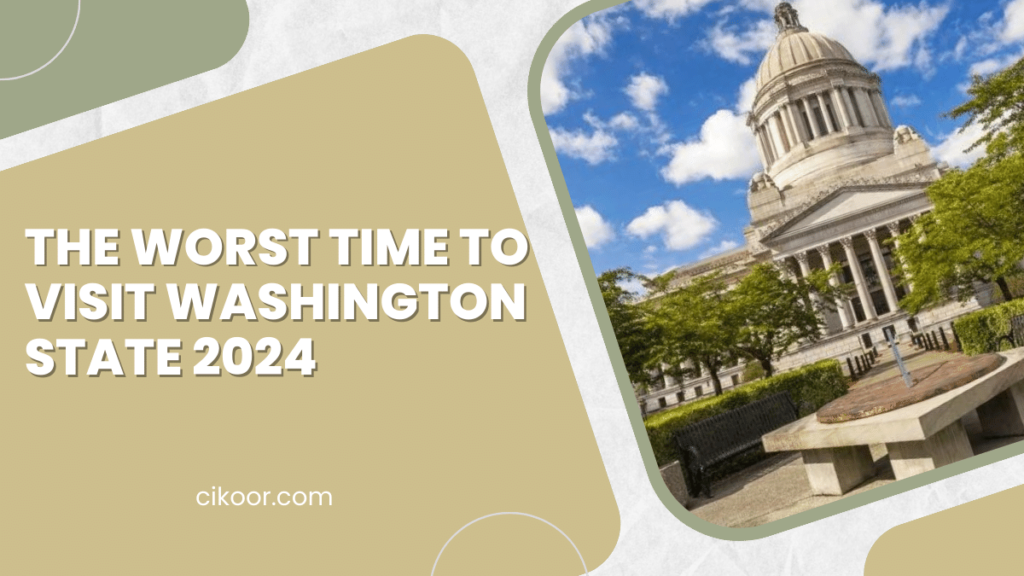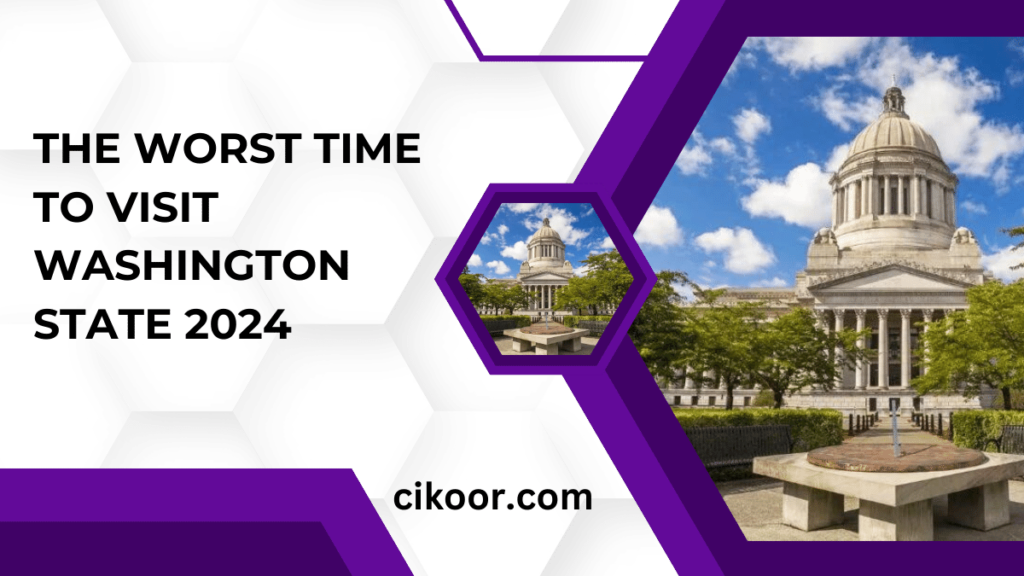Are you aware of the worst time to visit Washington State? Planning your trip at the right time can make all the difference. Discover the pitfalls of campgrounds and avoid the crowds, high prices, unfavorable weather conditions, snow, and season. Make sure your visit is unforgettable for all the right reasons.
Table of Contents
Key Takeaways
- Plan Around Peak Tourist Seasons: Avoid the summer months when tourist crowds peak to experience Washington State with more tranquility and fewer crowds.
- Consider Weather Challenges: Be prepared for varying weather conditions throughout the year, especially in winter, to make the most of your visit and key events.
- Explore Spring and Fall: Opt for visiting during spring or fall for milder weather and fewer limitations on outdoor activities compared to winter.
- Account for Ferry Travel: Factor in potential delays and challenges when using ferries for transportation, especially during peak travel times.
- Adapt Outdoor Plans: Adjust outdoor activity plans based on seasonal restrictions and limitations, ensuring a more enjoyable experience.
- Stay Informed About State Events: Be aware of major state events that could impact your visit, affecting crowd sizes and accommodation availability.
Identifying Peak Tourist Seasons
Analyzing Data
Tourist activity data reveals peak seasons in Washington State, aiding in avoiding crowded attractions.
Visitors flock to popular destinations during summer, major holidays, and key events, causing overcrowding.
Consider school breaks and events like festivals when planning trips to ensure a pleasant experience.
Opting for Off-Peak Visits
Choosing off-peak times guarantees a more serene exploration of Washington’s beauty without the hustle and bustle.
Off-peak seasons offer lower accommodation rates, shorter queues at attractions, and a more intimate experience with nature.
Plan visits during spring or fall to enjoy mild weather, fewer tourists, and the stunning natural landscapes without the crowds.
Weather Challenges Throughout the Year
Diverse Patterns
Washington State boasts a variety of weather patterns due to its diverse landscape and proximity to the Pacific Ocean. The western region experiences milder temperatures influenced by oceanic conditions, while the eastern part encounters more extreme seasonal changes.
Impact on Travel
Unpredictable storms and heavy snowfall during winter can disrupt travel plans and outdoor activities, especially in mountainous regions. Shoulder seasons bring fluctuating conditions, making it essential for travelers to be prepared for sudden changes.
Best Times to Visit
For those seeking mild temperatures and fewer crowds, consider visiting Washington State during the summer months. However, if you enjoy winter sports or picturesque snow-covered landscapes, the colder months offer unique experiences.
Winter Season Limitations
Snowstorms Impact
During the winter season in Washington State, snowstorms can significantly impact travel plans, leading to flight cancellations and road closures. The heavy snowfall can create hazardous driving conditions, making it challenging for tourists to navigate through the state.
Indoor Activities To avoid the disruptions caused by ski season, visitors can explore alternative indoor activities. Museum visits provide a cultural experience, while indoor markets offer a taste of local produce and crafts. wine tasting tours in cozy wineries are perfect for enjoying the winter months without worrying about weather-related obstacles.
Freezing Temperatures Concerns
The freezing temperatures during winter in Washington State pose risks of frostbite and hypothermia to those unprepared for the cold. It is essential for travelers to dress warmly and carry emergency supplies when venturing outdoors to prevent any weather-related health issues.
Alternative Indoor Activities In light of the challenges posed by the ski season, tourists can engage in indoor recreational activities such as visiting art galleries or attending theater performances. These options provide entertainment while ensuring safety and comfort during the colder months.
Spring and Fall Considerations
Weather Variability
Spring and fall in Washington State offer mild temperatures and stunning fall colors, making them ideal for outdoor enthusiasts. However, unpredictable weather patterns can pose challenges, with sudden rain showers or temperature fluctuations.
Despite the potential limitations, visitors can still enjoy various activities by planning ahead. For instance, packing layers to accommodate changing temperatures is essential. Having a backup indoor itinerary can ensure a seamless experience even if outdoor plans are disrupted.
Timing Considerations
When visiting in May, travelers can witness the vibrant bloom of wildflowers in full swing during spring. In contrast, fall presents an opportunity to admire the breathtaking foliage as trees transition to their autumn hues.
To make the most of these seasons, consider exploring national parks such as Mount Rainier or Olympic National Park. These locations offer picturesque landscapes that truly showcase the beauty of spring blooms or fall colors.
Navigating Ferry Travel Difficulties

Peak Periods
Ferry travel in Washington State can be challenging during peak periods due to high demand. Delays are common, especially on popular routes to islands like Bainbridge and Vashon.
During these times, consider alternative transportation options if possible. Exploring roads or utilizing other modes of transport can help you avoid the long wait times associated with ferry travel.
Strategies for Efficiency
To minimize delays, plan your trip outside of peak hours. Trails and back roads can offer scenic alternatives to main highways prone to congestion. Opt for less-traveled routes to bypass heavy traffic areas.
- Utilize online resources to check construction updates and potential road closures before embarking on your journey.
- Arrive at the ferry terminal early to secure a spot, especially during weekends and holidays when demand is high.
Comparison of Options
When deciding between ferry travel and road trips, weigh the pros and cons of each. While ferries provide a unique experience, they may not always be the most time-efficient choice.
Consider factors such as cost, convenience, and flexibility when choosing your mode of transportation. Road trips offer more control over your schedule but may lack the charm of a ferry ride through the Puget Sound.
Outdoor Activities Restrictions
Weather Impact
Outdoor activities in Washington State can be severely impacted by the unpredictable weather, affecting hiking and camping plans. The state’s notorious rain can turn trails into muddy quagmires, making them unsafe for exploration.
Despite the allure of the lush green landscapes during shoulder seasons, visitors must be cautious of the risks posed by slippery paths. It’s crucial to prioritize safety above all else when engaging in outdoor pursuits during these times.
Safety Concerns
The transition periods between seasons bring about unique challenges for outdoor enthusiasts. Muddy and slippery trails can lead to accidents and injuries if proper precautions are not taken. National parks and hiking areas may have restrictions in place to ensure visitor safety.
It is essential to check for any trail closures or restrictions due to adverse weather conditions before embarking on any outdoor adventures. Being aware of these limitations can prevent potential mishaps and guarantee a safer experience for all visitors.
Dealing with Tourist Crowds
Managing Congestion
Crowded attractions and high hotel prices are common during peak times in Washington State. To avoid the congestion, plan your trip during off-peak seasons. Consider visiting lesser-known parks and attractions to escape the crowds.
Explore hidden gems like the Olympic National Forest or North Cascades National Park for a more peaceful experience. These destinations offer stunning landscapes without the hustle and bustle of popular tourist spots.
Navigating Festival Seasons
During festival seasons, such as the Skagit Valley Tulip Festival or Bumbershoot in Seattle, expect even more significant crowds. If you prefer quieter surroundings, steer clear of these events. Opt for exploring local hiking trails or small towns instead.
Experience the tranquility of places like Leavenworth or Walla Walla, known for their charm and fewer tourists compared to major cities like Seattle or Spokane.
Notable State Events Impact
Major Events
Washington State hosts key events and festivals that draw large crowds each year. The Seattle International Film Festival, attracting film enthusiasts worldwide, and the Washington State Fair with its diverse entertainment options are among the most popular state events. These gatherings create vibrant atmospheres but also lead to increased traffic congestion.
Traffic Challenges
During these events, navigating through the state can be a daunting task due to heavy traffic and crowded streets. Visitors often face challenges finding parking spots and dealing with long commute times. The influx of tourists during peak event seasons adds to the usual traffic congestion in urban areas like Seattle.
Planning for Quiet Visits
To avoid the hustle and bustle of major state events, visitors can plan their trips during off-peak times or opt for lesser-known festivals. Exploring hidden gems such as Leavenworth’s Christmas Lighting Festival or the Sequim Lavender Festival offers a quieter experience away from the crowds. By scheduling visits strategically, tourists can enjoy a more peaceful exploration of Washington State.
Planning for Quieter Visits
Timing
Plan your trip during off-peak seasons to avoid crowds and enjoy a more peaceful experience. Avoid summer months for camping in popular areas.

Research Conduct thorough research on lesser-known destinations and hidden gems to escape the tourist rush. Explore local blogs and forums for insider tips.
Flexibility
Stay flexible with your itinerary to adapt to changing conditions and unexpected opportunities. Leave room for spontaneous detours and discoveries along the way.
Hidden Gems
Discover tranquil spots like the Hoh Rainforest, known for its serene beauty away from bustling cities. Consider visiting the San Juan Islands for a peaceful island getaway.
- Bullet list:
- Plan trips during off-peak seasons
- Research hidden gems and lesser-known attractions
- Stay flexible with your itinerary
Summary
Now that you have a better understanding of the best and worst times to visit Washington State, you can plan your trip more strategically. Be mindful of peak tourist seasons, weather challenges, and outdoor activity restrictions to make the most out of your visit. Consider quieter times if you prefer a more relaxed experience and aim to attend notable state events for a unique touch to your trip.
Remember to navigate ferry travel difficulties and deal with tourist crowds effectively to ensure a smooth journey. By planning ahead and being aware of these factors, you can optimize your visit to Washington State and create unforgettable memories.
Frequently Asked Questions
When is the worst time to visit Washington State?
The worst time to visit Washington State in terms of weather and crowds is during the winter season, particularly from late November to early February. The cold, rainy weather and limited outdoor activities make it less appealing for tourists.
What are the limitations of visiting Washington State in winter?
Winter in Washington State brings cold temperatures, frequent rain, and snow in certain areas like the Cascades. Many outdoor activities are limited due to weather conditions, making it challenging for tourists who prefer exploring nature and engaging in outdoor adventures.
How can one avoid tourist crowds when visiting Washington State?
To avoid tourist crowds in Washington State, consider planning your visit during the shoulder seasons of spring or fall. These periods offer milder weather conditions, fewer crowds at popular attractions, and better opportunities to explore the state’s natural beauty without feeling overwhelmed by tourists.
Are there any notable state events that can impact a visit to Washington State?
Yes, notable state events like festivals, concerts, or major sporting events can significantly impact tourism in Washington State. It is advisable to check event calendars and plan your visit accordingly if you wish to avoid potential crowds or take part in specific events during your trip.
How can one plan for a quieter visit to Washington State?
For a quieter visit to Washington State, consider visiting during weekdays instead of weekends. Exploring off-the-beaten-path destinations or opting for less popular attractions can help you experience a more peaceful and serene side of the state away from the usual tourist hustle and bustle.